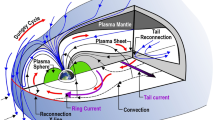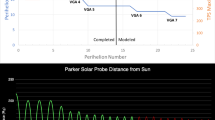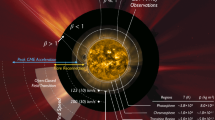Abstract
The CME’s structure of solar wind (interplanetary magnetic field) is different from CIR’s. The two processes in which plasma and solar wind energy are injected into the Earth’s inner magnetosphere are not the same. So, the variations of energetic electrons flux in the radiation belts are different between the storms associated with CMEs and CIRs. By using data from SAMPEX (Solar, Anomalous, and Magnetospheric Particle Explorer) satellite, we have investigated the dynamic variations of the outer radiation belt for 1.5–6.0 MeV electrons during 54 CME-driven storms and 26 CIR-driven recurrent storms. According to the superposed epoch analysis, for CME- and CIR-driven storms, when the Dst index reaches the minimum, the locations of the outer boundary move to L=4 and L=5.5, respectively. In the recovery phases, the locations of the outer boundary of the outer radiation belt are generally lower than and slightly higher than those before CME- and CIR-driven storms, respectively. We have found that the logarithmically decaying 1/e cut-off L-shell is a satisfying indicator of the outer boundary of the outer radiation belt. Furthermore, our study shows that the logarithmically decaying 1/e cut-off latitude is dependent on the Kp index in the main phases of CME- and CIR- driven storms, while in the recovery phases, there is no obvious correlation. In addition, it has been shown that the locations of the peak electron flux are controlled by the minimum Dst index in the main phases of CME-driven storms. The influences of multiple storms on the electron flux of outer radiation belt have also been investigated.
Similar content being viewed by others
References
Zong Q G. Ultralow frequency modulation of energetic particles in the dayside magnetosphere. Geophys Res Lett, 2007, 34, L12105, doi: 10.1029/2007GL029915
Zong Q G, Wang Y F, Yang B, et al. Recent progress on ULF waves and its interactions with energetic particles in the inner magnetosphere. Sci China Ser E-Tech Sci, 2008, 51: 1–6
Zong Q G, Hao Y, Wang Y F, et al. Ultra low frequency (ULF) waves impact on radiation belt energetic particles. Sci China Ser E-Tech Sci, 2009, 51: 1–6
Zong Q G, Zhou X Z, Wang Y F, et al. Energetic electron response to ULF waves induced by interplanetary shocks in the outer radiation belt. J Geophys Res, 2009, 114, A10204, doi:10.1029/2009JA014393
Xiao F, Su Z, Zheng H, et al. Modeling of outer radiation belt electrons by multidimensional diffusion process. J Geophys Res, 2008, 114, A03201, doi:10.1029/2008JA013580
Xiao F, Zong Q G, Chen L. Pitch-angle distribution evolution of energetic electrons in the inner radiation belt and slot region during the 2003 Halloween storm. J Geophys Res, 2008, 114, A01215, doi:10.1029/2008JA013068
Xiao F. Three-dimensional simulations of outer radiation belt electron dynamics including cross-diffusion terms. J Geophys Res, 2010, 115, A05216
Xiao F. Modelling energetic particles by a relativistic kappa loss cone distribution function in plasmas. Plasma Phys Control Fusion, 2006, 48: 203
Xiao F. Energetic electron distributions fitted with a relativistic kappa-type function at geosynchronous orbit. J Geophys Res, 2008, 113, A05203
Xiao F. Whistler instability threshold condition of energetic electrons by kappa distribution in space plasmas. J Geophys Res, 2006, 111, A08208
Xiao F. Instability of whistler-mode waves by a relativistic kappa-loss-cone distribution in space plasmas. Plasma Phys Controlled Fusion, 2006, 48, 1437
Baker D N, Kanekal S G, Li X, et al. An extreme distortion of the Van Allen belt arising from the ‘Halloween’ solar storm in 2003. Nature, doi:10.1038/nature03116
Li X, Roth I, Temerin M, et al. Simulation of the prompt energization and transport of radiation particles during the March 24, 1991 SSC. Geophys Res Lett, 1993, 20: 2423
Li X, Barker A B, Baker D N, et al. Modeling the deep penetration of outer belt electrons during the ‘Halloween’ magnetic storm in 2003. Space Weather, 2008, 7, S02004, doi:10.1029/2008SW000418
Koller J, Chen Y, Reeves G D, et al. Identifying the radiation belt source region by data assimilation. J Geophys Res, 2007, 112, A06244, doi:10.1029/2006JA012196
Gonzalez W D, Tsurutani B T, Gonzalez A L. Interplanetary origin of geomagnetic storms. Space Sci Rev, 1999, 88: 529
Tsurutani B T. Interplanetary origin of geomagnetic activity in the declining phase of the solar cycle. J Geophys Res, 1995, 100: 21717
Kataoka R, Miyoshi Y. Flux enhancement of radiation belt electrons during geomagnetic storms driven by coronal mass ejections and corotating interaction regions. Space Weather, 2006, 4, S09004, doi:10.1029/2005SW000211
Mcpherron R L. Statistical properties of the solar wind and IMF at 1 AU, Eos Trans. AGU, 87(52). Fall Meet Suppl, Abstract SH43C-01, 2006
Cook W R. PET: a proton/electron telescope for studies of magnetospheric, solar, and galactic particles. IEEE Trans Geosci Rem Sensing, 1993, 31: 565
Axford W I. Magnetospheric convection. Rev Geophys Space Phys, 1969, 7: 421
Vasyliunas V M. Mathematical models of magnetospheric convection and coupling to the ionosphere, in Particles and Fields in the Magnetosphere. Netherlands, 1970
Chappell C R. The convergence of fact and theory on magnetospheric convection. In: Correlated Interplanetary and Magnetospheric Observations. Netherlands, 1974
Stern D P. Quantitative models of magnetic and electric fields in the magnetosphere. NASA-GSFC Doc. X-602-75-90, 1975
Kavanagh L D, Freeman J W, Chen A J. Plasma flow in the magnetosphere. J Geophys Res, 1968, 73: 5511
Chen A J. Penetration of low-energy protons deep into the magnetosphere. J Geophys Res, 1970, 75: 2458
Mozer F S. Origin and effects of electric fields during isolated magnetospheric substorms. J Geophys Res, 1971, 76: 7595
Volland H. A semiempirical model of large-scale magnetospheric electric fields. J Geophys Res, 1973, 78: 171
Mozer F S, Lucht P. The average auroral zone electric field. J Geophys Res, 1974, 79: 1001
Snyder C W, Neugebauer M, Rao U R. The solar wind velocity and its correlation with cosmic ray variations and with solar and geomagnetic activity. J Geophys Res, 1963, 68: 6361
Vasyliunas V M. A crude estimate of the relation between the solar wind speed and the magnetospheric electric field. J Geophys Res, 1968, 73: 2529
Wilcox J M, Schatten K, Ness N. Influence of interplanetary magnetic field and plasma on geomagnetic activity during quiet sun conditions. J Geophys Res, 1967, 72: 19
Carpenter D L. Relations between the dawn minimum in the equatorial radius of the plasmapause and Dst, Kp, and local K at Byrd Station. J Geophys Res, 1967, 72: 2969
Chappell C R, Harris K K, Sharp G W. A study of the influence of magnetic activity on the location of the plasmapause as measured by Ogo 5. J Geophys Res, 1970, 75: 50
Schatten K H, Wilcox J M. Response of the geomagnetic activity index Kp to the interplanetary magnetic field. J Geophys Res, 1967, 72: 5185
Mendillo M, Papagiannis M D. Estimate of the dependence of the magnetospheric electric field on the velocity of the solar wind. J Geophys Res, 1971, 76: 6939
Freeman J W. Kp dependence of the plasma sheet boundary. J Geophys Res, 1974, 79: 4315
Kivelson M G. Magnetospheric electric fields and their variation with geomagnetic activity. Rev Geophys Space Phys, 1976, 14: 189
Author information
Authors and Affiliations
Corresponding author
Rights and permissions
About this article
Cite this article
Yuan, C., Zong, Q. Dynamic variations of the outer radiation belt during magnetic storms for 1.5–6.0 MeV electrons. Sci. China Technol. Sci. 54, 431–440 (2011). https://doi.org/10.1007/s11431-010-4269-9
Received:
Accepted:
Published:
Issue Date:
DOI: https://doi.org/10.1007/s11431-010-4269-9




